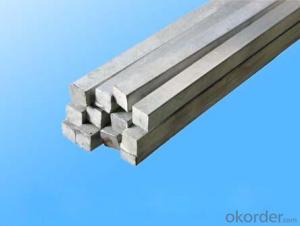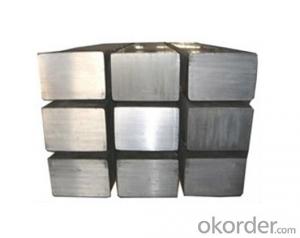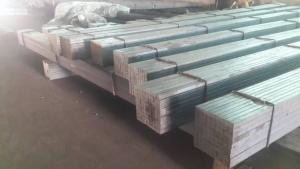Q195Cr High Quality Steel Square Bar
- Loading Port:
- Tianjin
- Payment Terms:
- TT OR LC
- Min Order Qty:
- 1000 m.t.
- Supply Capability:
- 100000 m.t./month
OKorder Service Pledge
OKorder Financial Service
You Might Also Like
Product Description:
Product Description:
In the production of steel products, steel is molded and reshaped with different machinery at different temperatures. One process is steel rolling, which involves metal stock passing through a pair of rolls. Rolling produces flat steel sheets of a specific thickness, and the process is classified according to the temperature at which the metal is rolled. If the temperature of the metal is above its recrystallization temperature, or the temperature at which the grain structure of the metal can be altered, then the process is termed as hot rolling. If the temperature of the metal is below its recrystallization temperature, the process is termed as cold rolling.
Like cold rolling, cold drawing is performed at room temperature, but instead of producing a flat object like a coke can, cold drawing makes steel into the form of a wire like the spokes of a wheel or a paper clip. To start the process, Steel is usual hammered and rolled so that it can be fit through a die; a tool that turns the steel mass into a wire. The room temperature steel is pulled through the die which reshapes it into a thinner shape while maintaining the same volume. It is similar to the idea of syrup flowing out of a bottle through a tube in that it changes shape but not volume, but instead of squeezing the metal, it is pulled out. In order to get the wire down to the right diameter, it usually requires more than one pass through different dies.
Colddrawn steel, steel covered carbon steel, excellent carbon steel, alloy structural steel, carbon tool steel, spring steel, bearing steel, tool steel, cold heading steel, free cutting steel, martensite stainless steel; products include all kinds of shapes round, square steel, hexagonal, flat steel and other conventional products, including various special-shaped steel products. In all types of colddrawn steel industry has been widely used, these areas include automotive, machine tools, furniture, standard parts, textile machinery, agricultural machinery, military industry and other industries.
The total assets of more than 40 million, as of the end of 2010 with fixed assets of 34 million, with 60 tons from 5 tons a chain drawing machine 10 sets, horizontal and inverted coiled wire drawing machine 5 sets, steel and plate production line of blasting, high-power ham stove, various straightening machine and cold rolling mill and other major equipment.
Usage/Applications
-The Square Bar is normally used as structure steel.
-Row material for other structure steel like steel angles, channels, I-beams, H-beams, etc…
Packaging & Delivery
-Packing Detail: The products can be packed in bundles by steel wires.
-Marks: We make tag marks and color marks. The tag marks with white background and red company logo will be tied up to each bundle of the products. The information is usually including basic information of products and company and other information requested by customers. As for color marks, we will paint both ends of bundles to make sure that it w
-Delivery Detail: 30~45 working days after receive buyer’s T.T. or L/C.
ill be more convenient for customers to distinguish them from other products.
- Q:What are the different techniques for using a steel square in woodworking joinery?
- Woodworking joinery can be achieved with accuracy and precision using various techniques with a steel square. These techniques serve specific purposes and are commonly used in woodworking. Here are some examples: 1. Squareness check: To ensure perfect square corners in joints or workpieces, the steel square is indispensable. By placing the square against the workpiece's edge, you can verify if the adjoining edge is perpendicular to it. This technique is crucial for creating sturdy and stable joints. 2. 90-degree angle marking: When marking a 90-degree angle on a workpiece, the steel square is a useful tool. By aligning the square with the workpiece's edge and tracing along its inside edge using a pencil or marking knife, consistent and accurate marking can be achieved for precise joinery. 3. Marking non-90-degree angles: Steel squares often have additional markings that facilitate measuring and marking angles other than 90 degrees. By aligning the desired angle measurement with the workpiece's edge, you can accurately mark the angle required for complex joinery. 4. Plumb and level determination: Steel squares can be used to check if a workpiece is plumb (vertical) or level (horizontal). By holding the square against the workpiece's edge and using a spirit level or plumb bob, proper alignment of the project can be ensured. 5. Measurement transfer: Steel squares are also useful for transferring measurements from one workpiece to another. By aligning the square with the edge of the first workpiece and marking the desired measurement, you can then transfer that measurement to the second workpiece using the square as a guide. 6. Mitered corner creation: When working with mitered corners, the steel square is essential for achieving accurate angles. By placing the square against the workpiece and aligning it with the desired angle, precise marking and cutting of the joint can be accomplished, resulting in clean and tight mitered corners. In conclusion, the steel square is a versatile and valuable tool for woodworking joinery. Whether you need to check for squareness, mark angles, determine plumb and level, transfer measurements, or create mitered corners, the steel square provides the precision and accuracy required for successful woodworking projects.
- Q:How do you use a steel square to create parallel lines?
- In order to generate parallel lines, one must adhere to a few straightforward measures when utilizing a steel square. Firstly, position the steel square on the designated surface or material where the parallel lines are desired. It is essential to ensure that the longer side of the square aligns parallel to the material's edge. Subsequently, employ a pencil or scribe to mark a straight line along the steel square's edge. It is crucial that the line is of sufficient length for the intended parallel lines. Once the initial line has been created, proceed to slide the steel square along the edge, guaranteeing alignment with the previously marked line. Continuously verify that the longer side of the square remains parallel to the material's edge. Using the same pencil or scribe, proceed to mark another line along the steel square's edge. This line should run parallel to the first one that was made. Repeat this procedure as many times as necessary to achieve the desired quantity of parallel lines. On each occasion, shift the steel square along the edge and delineate a fresh line that is parallel to the preceding one. By employing a steel square in this fashion, one can effortlessly produce precise and parallel lines on a diverse range of materials, such as wood, metal, or paper. The steel square acts as a guide, ensuring the maintenance of parallel alignment and accuracy in measurements.
- Q:Can a steel square be used for measuring angles in concrete work?
- Yes, a steel square can be used for measuring angles in concrete work. Steel squares are versatile tools that can be used for various applications, including measuring and marking angles. They have a right angle shape, with one side being 90 degrees, which makes them particularly useful for checking the accuracy of corners and angles in concrete work. By placing the steel square against the corner or angle being measured, it can assist in ensuring that the concrete is being laid at the correct angle and in maintaining the integrity of the structure being built. Additionally, steel squares are typically made of durable materials that can withstand the rigors of concrete work, making them a reliable tool for measuring angles in this context.
- Q:How accurate are steel squares for measuring?
- Steel squares are known for their high accuracy in measuring angles and lengths. They are precision tools that are typically made from hardened steel, providing stability and durability. When properly calibrated and used correctly, steel squares can provide accurate measurements for a wide range of applications. One of the key advantages of steel squares is their ability to maintain their accuracy over time. Unlike other materials, steel does not warp or deform easily, ensuring that the measurements obtained are reliable and consistent. This stability makes steel squares a preferred choice in various industries, including woodworking, metalworking, and construction. Furthermore, the edges and surfaces of steel squares are precisely machined, allowing for accurate alignment and marking. The right angles formed by the square are typically very close to perfect 90-degree angles, making them suitable for tasks that require precise right angles, such as squaring up corners or checking the accuracy of machinery. However, it is worth noting that the accuracy of steel squares can be influenced by factors such as user error, wear and tear, or improper storage. To ensure the highest level of accuracy, it is important to handle steel squares with care and to periodically check their calibration using a reliable reference square or angle gauge. In conclusion, steel squares are generally highly accurate tools for measuring angles and lengths. With their robust construction and precise machining, they provide consistent and reliable results. By properly maintaining and calibrating them, steel squares can be trusted for a wide range of measurement tasks.
- Q:How do you use a steel square to determine the length of a beam?
- To use a steel square to determine the length of a beam, follow these steps: 1. Start by finding a level and flat surface to work on. This will ensure accurate measurements. 2. Place the steel square on one end of the beam, with the long side of the square against the side of the beam. 3. Align the square so that the 90-degree angle is perpendicular to the beam's length. 4. With one hand holding the square firmly in place, extend the other hand to mark the point where the beam ends on the square's long side. 5. Move the square along the beam, aligning the 90-degree angle with the previous mark made on the square. Repeat the process of marking the beam's length on the square. 6. Continue moving the square along the beam and marking its length until you reach the other end. 7. Once you have marked the entire length of the beam on the square, measure the distance between the first and last marks on the square using a measuring tape or ruler. 8. The measured distance between the marks on the square represents the length of the beam. It is important to note that when using a steel square, ensuring the square is securely placed against the beam and maintaining a consistent angle throughout the process will result in accurate measurements.
- Q:What are some common uses of a steel square in metalworking jewelry making?
- Some common uses of a steel square in metalworking jewelry making include measuring and marking angles, ensuring straight and accurate cuts or bends, checking for squareness or alignment, and creating precise templates or patterns. It is also helpful in layout work, scribing lines, and verifying dimensions during the fabrication process.
- Q:How do you use a steel square to measure and mark 45-degree angles?
- In order to measure and mark 45-degree angles using a steel square, the following steps should be followed: 1. Begin by placing the steel square on the desired material, ensuring that one of the square's edges aligns with the material's edge. 2. Identify the 45-degree angle on the steel square. Typically, this angle is indicated by a diagonal line intersecting the 90-degree angle. 3. Align the steel square in a way that the diagonal line representing the 45-degree angle matches the material's edge. Also, ensure that the opposite edge of the square runs parallel to the material's opposite edge. 4. Once the steel square is correctly positioned, utilize a pencil or scribe to mark the material along the square's edge. 5. For utmost accuracy and precision, it is advisable to mark the angle on both sides of the material. This can be accomplished by flipping the steel square and repeating the procedure on the opposite side. By adhering to these instructions, one can proficiently utilize a steel square to accurately and consistently measure and mark 45-degree angles.
- Q:What are some common features of steel squares?
- Steel squares possess several common characteristics, including: 1. Material: Crafted from high-quality steel, these squares exhibit exceptional durability and strength. 2. Shape: Typically resembling a right-angled triangle, steel squares possess one elongated side and two shorter sides that form a perfect 90-degree angle. 3. Precision: Meticulously engineered, steel squares guarantee precise measurements and angles. Their edges and corners undergo meticulous machining to deliver consistent and accurate results. 4. Markings: Often adorned with markings along their edges, steel squares offer users the ability to measure and indicate specific lengths or angles. 5. Graduations: Some steel squares are embellished with engraved or printed scales, allowing for easier measurement of angles or distances. 6. Versatility: Steel squares serve a multitude of purposes, including measuring, marking, and verifying right angles, as well as determining and transferring angles. 7. Size and weight: Steel squares are available in various sizes, ranging from compact pocket-sized squares to larger ones designed for heavy-duty applications. The weight of a steel square varies depending on its size and thickness. 8. Corrosion resistance: To prolong their lifespan, steel squares are often treated or coated to enhance their resistance to rust and corrosion. 9. Stability: Engineered for stability and rigidity, steel squares provide a dependable reference point for precise measurements and layout work. 10. Multi-functionality: Certain steel squares may incorporate additional features, such as built-in spirit levels, scribing tools, or adjustable components, offering enhanced versatility and convenience for specific applications.
- Q:How do you use a steel square to measure and mark 22.5-degree angles?
- To use a steel square to measure and mark a 22.5-degree angle, you need to follow a few simple steps. Firstly, position the steel square so that the long edge (hypotenuse) is facing you, and the shorter edge (leg) is on the left side. Ensure that the right angle formed by the two edges is placed at the starting point of your angle. Next, identify the scale on the leg of the square. This scale usually represents degrees, so find the 45-degree mark on the scale, which is halfway between 0 and 90 degrees. From the 45-degree mark, count two units to the right. Each unit on the scale represents one degree, so counting two units will give us 2 degrees. This is because a 45-degree angle is halfway between 0 and 90 degrees, and half of 45 is 22.5. Once you have identified the 2-degree mark, draw a line using a pencil along the edge of the square that runs through this mark. This line will represent a 22.5-degree angle. To double-check your measurement, you can also measure the angle using a protractor. Place the protractor at the starting point of your angle and align its baseline with the line you drew using the steel square. Ensure that the protractor's zero-degree line aligns with the line from the square, and then confirm that the protractor reads 22.5 degrees. By following these steps, you can accurately measure and mark a 22.5-degree angle using a steel square.
- Q:How do you use a steel square for making right angle cuts?
- To use a steel square for making right angle cuts, you need to follow a few simple steps. First, ensure that your steel square is clean and in good condition. Then, place one edge of the square against the edge of the material you want to cut, making sure it is aligned properly. Next, hold the square firmly in place and use a pencil or marking tool to mark a straight line along the other edge of the square. This line will represent the right angle cut you want to make. Once you have marked the line, remove the square and double-check your markings to ensure they are accurate. Next, use a suitable cutting tool such as a saw or a power tool to cut along the marked line. Make sure to follow all safety precautions while using the cutting tool. Finally, after making the cut, you can use the steel square again to verify that the cut is indeed at a right angle. Place the square against the cut edge and check if it aligns perfectly with both sides of the material. By following these steps and using a steel square properly, you can ensure accurate and precise right angle cuts for your woodworking or construction projects.
1. Manufacturer Overview |
|
|---|---|
| Location | |
| Year Established | |
| Annual Output Value | |
| Main Markets | |
| Company Certifications | |
2. Manufacturer Certificates |
|
|---|---|
| a) Certification Name | |
| Range | |
| Reference | |
| Validity Period | |
3. Manufacturer Capability |
|
|---|---|
| a)Trade Capacity | |
| Nearest Port | |
| Export Percentage | |
| No.of Employees in Trade Department | |
| Language Spoken: | |
| b)Factory Information | |
| Factory Size: | |
| No. of Production Lines | |
| Contract Manufacturing | |
| Product Price Range | |
Send your message to us
Q195Cr High Quality Steel Square Bar
- Loading Port:
- Tianjin
- Payment Terms:
- TT OR LC
- Min Order Qty:
- 1000 m.t.
- Supply Capability:
- 100000 m.t./month
OKorder Service Pledge
OKorder Financial Service
Similar products
New products
Hot products
Related keywords



























